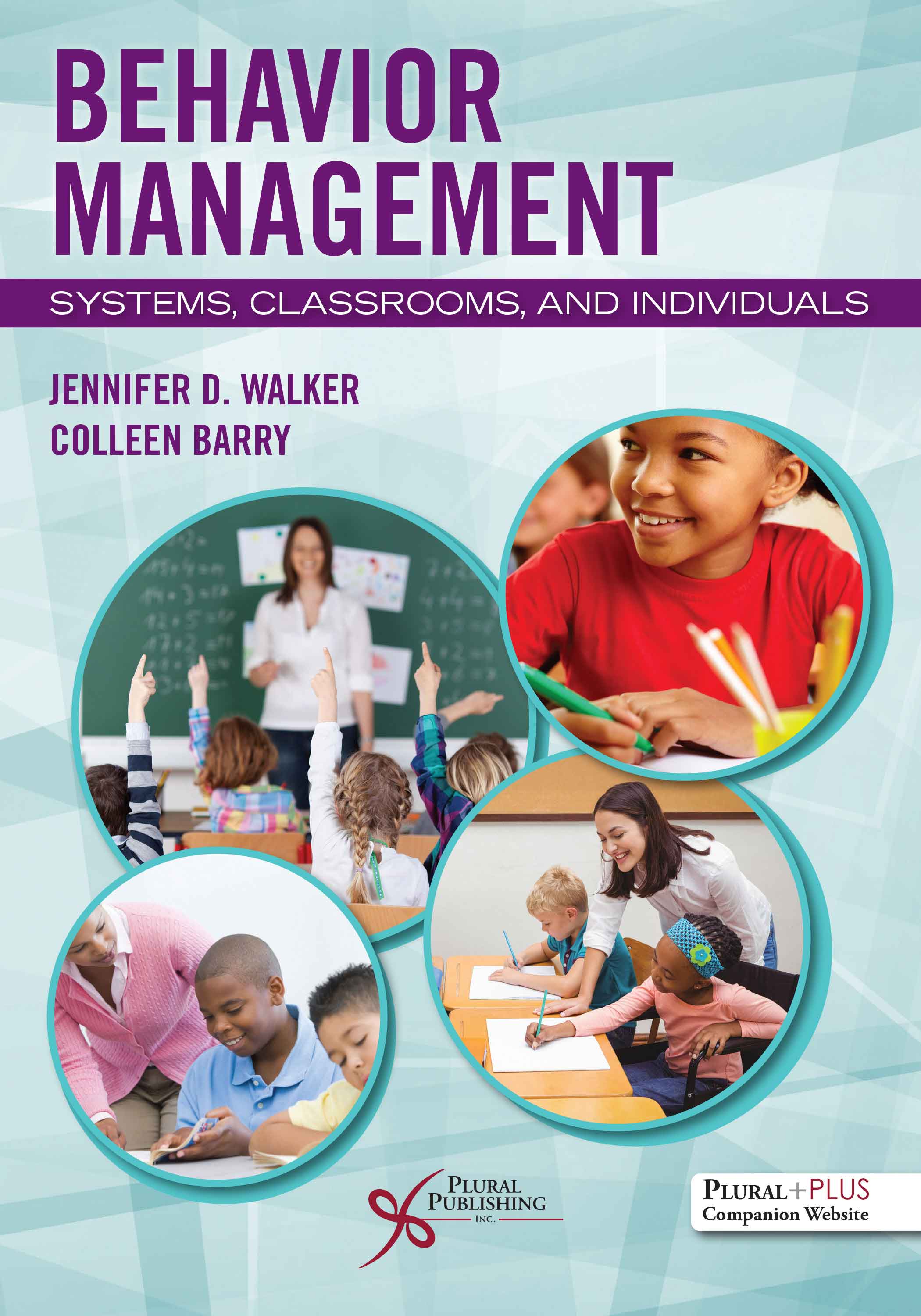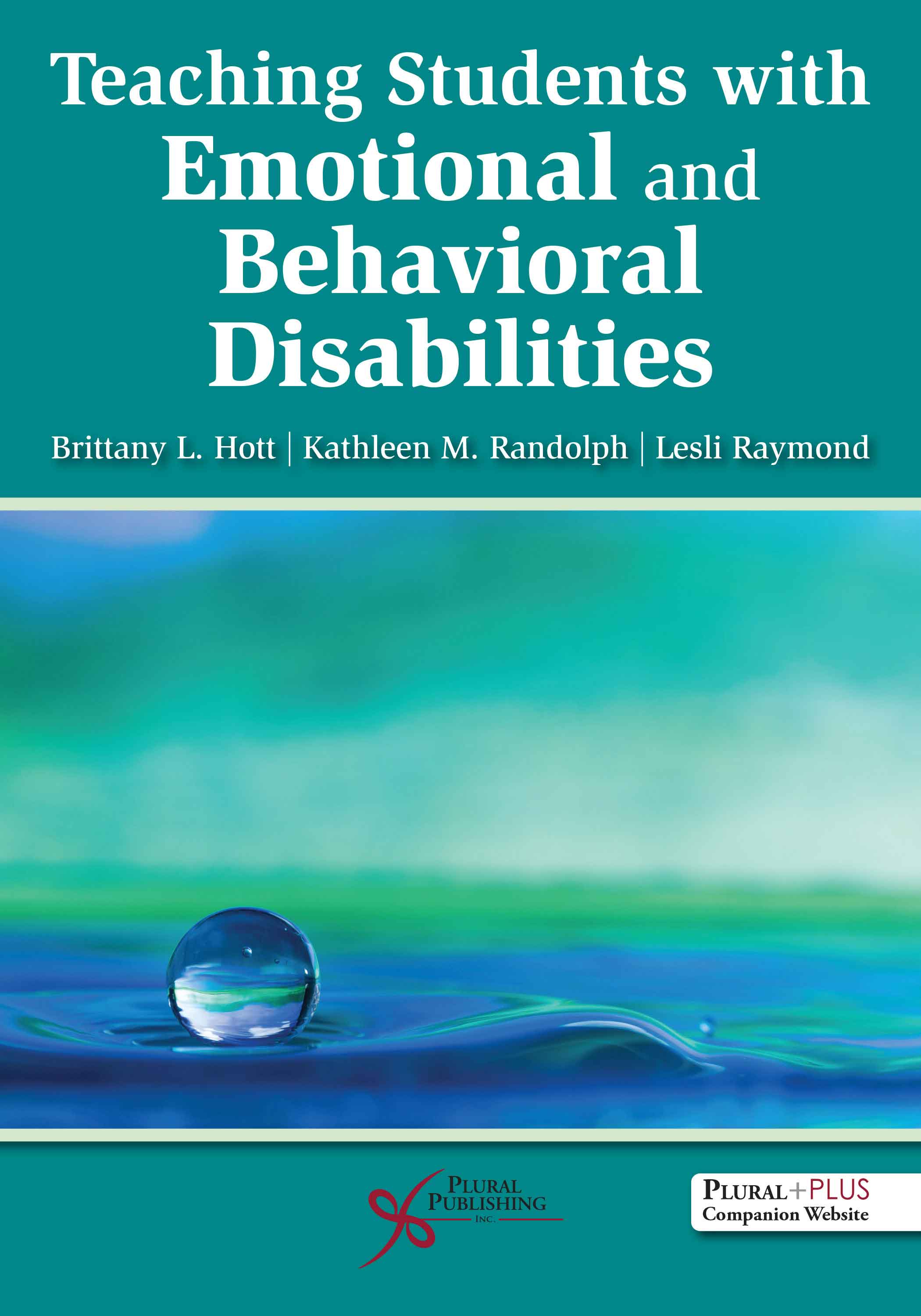
Behavior Management: Systems, Classrooms, and Individuals
First Edition
Jennifer D. Walker, Colleen Barry
Details: 381 pages, 2-Color, Softcover, 8.5" x 11"
ISBN13: 978-1-63550-224-4
© 2022 | Available
For Instructors
Purchase
Children and teens are simultaneously complex and predictable. Behavior theory and research can provide ways of predicting behaviors and designing classroom structures that benefit all students. Behavior Management: Systems, Classrooms, and Individuals is a highly readable, student-friendly textbook that meets the needs of both undergraduate and graduate teaching programs. By covering theory, systems, classrooms, and individuals, the authors have created a pragmatic resource that can be used by a range of individuals seeking reliable, evidence-based techniques integrating behavior management into effective classrooms, including both upcoming and established educators.
This text uses a funnel approach to guide readers from the “big picture” down to the individual student. Part I begins by introducing the foundations of classroom management with a discussion of prominent theorists, legislation, common disabilities, and the basics of behavior. Part II provides discussion on classroom management communities, including systems of support and structure in schools and classrooms. Part III focuses on the individual to give both current and future teachers tools for building and nurturing relationships with students and understanding and responding to student behavior. The final chapter offers tools for self-reflection and managing stress and burnout.
Key Features
- Real-world cases and classroom examples to integrate content with practice
- Chapters begin with learning objectives and key terms and end with summaries for comprehension
- Bolded terms along with a comprehensive glossary to improve retention of material
- “Make a Connection” boxes to synthesize content across chapters
- Content connections to high-leverage practices in call-out boxes
- Examples, figures, and templates to clarify and expand on key concepts
- Access to a PluralPlus companion website with case studies and instructor resources, including PowerPoint slides, test banks, and sample activities
Instructor test bank available on the Respondus Test Bank Network.
Reviews
“The content builds on theory and pulling it together for practice. The authors do a good job of explaining in lay terms difficult concepts and implications for educational practice. The guided reflections introduce the pre-service teacher to the concept of guided reflection or the process of self-inquiry. This allows for greater insight, self-development, and goal setting opportunities for improving their practice.”
—Denise A. Soares, PhD, (The University of Mississippi)
“Chapters are written clearly and contain accurate and important information. I really like how learning objectives are framed in relation to making SMART goals. This a very understandable and clear way to explain this concept for pre-service teachers. Overall, the section on reinforcement was very informative, engaging, easy to read/understand, and included helpful and practical information. The connections made to High Leverage Practice Alerts throughout the text are awesome!”
—Erika Pinter, PhD (Northern Illinois University)
“Overall, the book is very well written with many realistic examples and scenarios included throughout. I think it’s important to include a piece about teacher burnout and liked how this was incorporated at the end. I enjoyed reading the sections on special education, teacher reflection, and PBIS supports.”
—Cheryl K. Cunningham, PhD (Fort Hays State University)
"Exceptionally well written, organized and presented, [...] Behavior Management: Systems, Classrooms, and Individuals is especially and unreservedly recommended for classroom teacher, school administrators, and education advocates personal reading lists, as well as a core addition to school district, college, and university library Teacher Education collections."
—Library Bookwatch (March 2021)
“[…] each chapter of Behavior Management begins with learning objectives and key terms, ending with a summary. […]
The first chapter of the text […] explain laws related to disciplinary procedures, including manifestation determination reviews. […]
The remaining chapters in Part I describe cultural, social, and environmental factors influencing behavior. A positive and preventive approach addresses ways to cultivate a culturally responsive classroom. Unlike most texts, executive functions and their linkage to behavior are discussed. […]
Part II, ‘Classroom Management Communities,’ […] describes school-wide systems, including response to intervention and safety plans. […] This section then provides concrete information on developing a learning environment, classroom procedures, and routines that encourage successful behaviors. Self-reflection questions prompt students to consider points such as where the teacher’s desk should be located, how the students should be grouped, and the impact of various desk arrangements. Again, the text is unique in its emphasis on encouraging positive behaviors through a discussion of prompt hierarchies, student engagement, and motivation. […]
Part III, adding to the positive and preventive approach of the text, describes ‘meeting individual needs.’[…], this section begins with establishing relationships and addressing diversity and cultural differences. […] Specifics on functional behavioral assessment and the development of intervention plans are provided with multiple cases, examples, forms, and procedural descriptions. This section concludes with teaching new skills and the importance of social skills.
[…] In addition, the framework for Universal Design for Learning is introduced. In this section questions to ask during a job search are provided, along with a discussion of stress and burnout.
A strong aspect of this book is the pedagogical supports. Classroom examples are provided, along with tables summarizing complex information […]”
–Anne M. Bauer, Ed.D, University of Cincinnati, on Teachers College Record (December 2021)
"Walker and Barry nailed it with this book. They clearly and expertly explain the key concepts related to quality behavior management while making their work relatable to all educators. As an instructor, I especially appreciate the online resources which make my preparation for class very easy. My course is essentially laid out for me. These resources are the best I have ever had access to in my 10 years in higher education. I highly recommend this book and the online resources for quality content that will prepare special educators (honestly ALL educators) well and support the instructor in course preparation with high quality resources."
-Ruby L. Owiny, PhD (Minnesota State University, Mankato)
Preface
Acknowledgements
Reviewers
Part I. Foundations of Classroom Management
Chapter 1. Introduction to Behavior Management
Learning Objectives
Key Terms
Prominent Theorists of Behavior Management
B. F. Skinner
William Glasser
Thomas Gordon
Lee and Marlene Canter
Rudolf Dreikurs
Jacob Kounin
Curwin and Mendler
Identifying and Locating Evidence-Based Practices
Legal Considerations for Behavior and Consequences
Restraint and Seclusion
Landmark Legislation, Policies, and Processes
Manifestation Determination Review (MDR)
Conclusion
Chapter Summary
Chapter 2. Understanding Student Needs
Learning Objectives
Key Terms
Developmental Characteristics
Influence of Cultural, Social, and Environmental Factors
Students with Disabilities
Attention Deficit Hyperactivity Disorder
Executive Function Deficits
Emotional and Behavioral Disorders (EBD)
Specific Learning Disabilities (SLD)
Autism Spectrum Disorders (ASD)
Intellectual Disability
Conclusion
Chapter Summary
Chapter 3. Basics of Behavior
Learning Objectives
Key Terms
Applied Behavior Analysis
Operant Conditioning
Selecting and Using Reinforcers
Schedules of Reinforcement
Fixed Ratio (FR)
Variable Ratio (VR)
Fixed Interval (FI)
Variable Interval (VI)
Positive and Negative Reinforcement
Positive Reinforcement
Negative Reinforcement
Extinction
Punishment
Conclusion
Chapter Summary
Part II. Classroom Management Communities
Chapter 4. School-Wide Systems
Learning Objectives
Key Terms
Multi-Tiered System of Support
Response to Intervention
Positive Behavioral Interventions and Supports (PBIS)
PBIS Tiers of Intervention
Tier 1
Tier 2
Tier 3
School Safety Plans
Conclusion
Chapter Summary
Chapter 5. Classroom Management Collaboration and Communication
Learning Objectives
Key Terms
Working with Parents
Communicating About Behavior
Working with Other Professionals
Paraprofessionals
Coteaching Settings
Working with Administration
Conclusion
Chapter Summary
Chapter 6. Setting Up Physical Learning Environments
Learning Objectives
Key Terms
Physical Classroom Setup
Horseshoe
Rows
Clusters or Groups
Pairs
Individual Desks
Tables
Individual Considerations
Considerations for Movement and Safety
Learning Zones
Additional Considerations
Classroom Climate
Conclusion
Chapter Summary
Chapter 7. Setting Up the Classroom: Procedures, Expectations, Rules, and Prompt Hierarchies
Learning Objectives
Key Terms
Establishing Procedures
Establishing Expectations
Establishing Rules
Hierarchy of Prompts
Conclusion
Chapter Summary
Chapter 8. Engagement, Instruction, and Motivation
Learning Objectives
Key Terms
Motivation
Intrinsic vs. Extrinsic Motivation
SMART goals
Group Contingencies
Dependent Group Contingency
Independent Group Contingency
Interdependent Group Contingency
Considerations
Choose Relevant Reinforcers
Prerequisite Skills and Attainable Criterion
Potential Risks with Group Contingencies
Conclusion
Chapter Summary
Part III. Meeting Individual Needs
Chapter 9. Establishing Relationships with Students
Learning Objectives
Key Terms
Best Practices for Positive Relationships
Names
Sarcasm
Power Struggles
“Saving Face”
Conflict Cycle
Behavior-Specific Praise
Relationships Between Students
Recognizing Diversity and Cultural Differences
Relationship Building Activities
Conclusion
Chapter Summary
Chapter 10. Behavioral Data Collection
Learning Objectives
Key Terms
Identifying and Defining Target Behaviors
Methods of Behavioral Data Collection
Frequency Counts
Duration Recording
Time Sampling
Momentary Time Sampling
Latency
Magnitude (Force)
Topography
Permanent Products
Setting Data Collection Timelines
Data Collection Tools
Considerations for Data Collection
Conclusion
Chapter Summary
Chapter 11. Graphing and Data Analysis
Learning Objectives
Key Terms
Applied Behavior Analysis
Single-Subject Design
A-B Design
Reversal Designs
Multiple Baseline Design
Visual Displays of Data and Visual Analysis
Graphing
Visual Analysis
Conclusion
Chapter Summary
Chapter 12. Functional Behavioral Assessment
Learning Objectives
Key Terms
Functional Behavioral Assessment
Components of FBA
Indirect Assessment Strategies
Direct Assessment Strategies
Functional Analysis
Functions of Behavior
Attention
Escape
Access
Automatic
Conclusion
Chapter Summary
Chapter 13. Behavioral Intervention Plans
Learning Objectives
Key Terms
Replacement Behaviors
Constructing a Behavioral Intervention Plan
Considerations for Selecting Replacement Behaviors
Behavioral Intervention Plan
Setting Event Strategies
Antecedent Event Strategies
Behavioral Teaching Strategies
Consequence Strategies
Extinction
Reinforcement
Redirection
Safety Plans
Team Process
Conclusion
Chapter Summary
Chapter 14. Teaching New Skills
Learning Objectives
Key Terms
Behavior Contracts
Definition of Task
Definition of Reward
Task Record
Guidelines and Considerations
Token Economies
Target Behaviors
Tokens
Backup Reinforcers
Considerations for Token Economies
Social Skills
Social Skills Instruction
Character Education and Social-Emotional Curriculum
Modeling
Democratic Classrooms
Service Learning
Self-Monitoring
Step 1. Define the Target Behavior
Step 2. Choose a Monitoring System
Step 3. Set a Self-Monitoring Schedule
Step 4. Choose a Self-Monitoring Prompt
Step 5. Teach, Practice, and Reinforce
Conclusion
Chapter Summary
Part IV. Conclusion
Chapter 15. Reflective Practices
Learning Objectives
Key Terms
Teacher Self-Reflection
Identify
Gather Data
Questions
Analyze Data
Implement Change
Using a UDL Framework
Planning for the First Year of Teaching
Planning for the 20th Year of Teaching
Teacher Stress and Burnout
Conclusion
Chapter Summary
Glossary
References
Index
Behavior Management: Systems, Classrooms, and Individuals comes with access to supplementary student and instructor materials on a Pluralplus companion website.
STUDENTS:
To access the student materials, you must register on the companion website and log in using the access code printed on the inside front cover of your book.
INSTRUCTORS:
To access the instructor materials, you must contact Plural Publishing, Inc. to be verified as an instructor and receive your access code.
Email: instructormaterials@pluralpublishing.com
Tel: 866-758-7251 (toll free) or 858-492-1555
*Note for students: If you have purchased this textbook used or have rented it, your access code will not work if it was already redeemed by the original buyer of the book. Plural Publishing does not offer replacement access codes for used or rented textbooks.

Educating Students with Autism Spectrum Disorder: A Model for High-Quality Coaching
First Edition
Joshua K. Harrower, Louis G. Denti, Marcia Weber-Olsen
Details: 245 pages, B&W, Softcover, 7" x 10"
ISBN13: 978-1-59756-786-2
© 2016 | Available

Teaching Students with Emotional and Behavioral Disabilities
First Edition
Brittany L. Hott, Kathleen M. Randolph, Lesli Raymond
Details: 397 pages, Two-Color, Softcover, 7" x 10"
ISBN13: 978-1-63550-225-1
© 2022 | Available

Special Education Law and Policy: From Foundation to Application
First Edition
Jacqueline A. Rodriguez, Wendy Murawski
Details: 567 pages, 2-Color, Softcover, 7" x 10"
ISBN13: 978-1-63550-231-2
© 2022 | Available

Special Education in Today's Diverse Classrooms: Meeting the Needs of Students With Exceptionalities
First Edition
Shantel M. Farnan, Ruby L. Owiny
Details: 349 pages, Full Color, Softcover, 8.5" x 11
ISBN13: 978-1-63550-750-8
© 2027 | Available

Assessment in Special Education: Practical Applications for Teachers
First Edition
Melissa C. Jenkins, Kyena E. Cornelius, Kiersten K. Hensley, Dana L. Wagner
Details: 313 pages, Full Color, Softcover, 7" x 10"
ISBN13: 978-1-63550-760-7
© 2027 | Available


